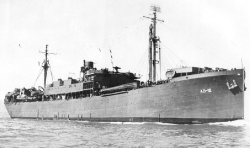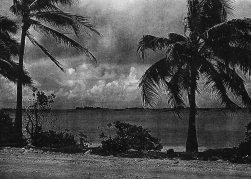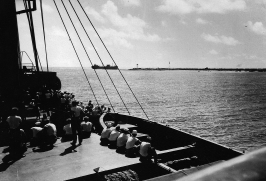Eniwetok, Marshall Islands
Travels and Sightseeing
Photographs taken by US Navy sailors in 1945
By Stephen Sherman, April, 2010. Updated March 21, 2012.
Eniwetok is a remote atoll in the Marshall Islands, and was a forward base for the US Navy in WW2. When my father traveled there with the US Navy in 1945, there wasn't much to do there, but the sailors made the best of it; his memoirs, which we pick up here, describe it.
The Swimming Exhibition
After we had been in Eniwetok, a tiny dot in the Pacific Ocean for a month or more, boredom started to set in. Someone came up with the idea of holding a swimming meet. Not a contest or competition but a kind of exhibition.
This was another example of the benevolence of the good Captain Curtis. He could have found excuses; like sharks, drownings, injuries, or whatever. But no, once again he saw the opportunity to do what he could to reduce boredom and it's companion, griping. He even granted permission to the ship's carpenters to build a little sailboat only a few would benefit from.
The swimming exhibition made quite a hit and that's pictured here. It looks like a real success doesn't it? Everybody had a good time and it was surprising that so many expert swimmers were among us.
The weather at Eniwetok was gorgeous all the while we were there. Again the Captain displayed his concern for the crew by permitting "beer parties" on a sandy out-cropping of the rim of the volcano that created the atoll. These were orderly affairs and free of any troubles or abuses. The crew of AD-12 was A-O.K.
Although this place seemed to be as far away from anywhere as it could be, it had its natural wonders and beauties. There are two that stand out.
The Surf
The most awesome of these are the rollers or as sometimes called, the breakers. Rollers is the most appropriate name. As they come rolling in to the shore they always approach at an angle, seldom parallel to the beach. They follow, one after the other, closely enough so that the roar they create is constant and ongoing. They also occur a great distance from shore because the coral reef that causes the action is several hundred yards offshore. An awe-inspiring scene!
Snorkeling on the Coral Reef
The other wonder of nature was not as easily seen. In fact it took some doing. Tropical fish!
The coral shelf was quite level and extended outward for one to two hundred yards and for a fairly uniform depth of less than four feet. At this depth and distance (the edge of the shelf) is the deep water. How deep? None of us tried to find out, but it was plenty deep.
Just in-shore of the breakers the water was wildly turbulent, bubbly and foamy. It didn't take us long to discover that beneath that foamy surface there were myriads of fish. It was a beautiful scene; like sharing the tank of a public aquarium. It was almost unbelievable. There were no large fish. Sharks did not venture inside of the breakers so we were safe. The variety of shapes, sizes and colors seemed endless. They were fearless so some would come right up and bump us. We made water tight masks of plexiglass and sheet rubber and an elastic band to keep them in place; no provision for breathing, so we just held our breath.
That trip to Eniwetok provided us with the most lasting memories of the Pacific cruise. Not bad for a ship that never went anywhere because she was stuck on a mountain of coffee grounds.
Sources:
Memoirs and photographs of Milton W. Sherman (1919-2010). He served in the U.S. Navy during WW2, on board the USS Denebola, AD-12, when he was in mid-twenties. On board the Denebola, he sailed to Eniwetok in late 1944, where he bought these vintage postcards from street vendors and the photos from the ship's photographer. You might enjoy reading a fuller version of his travels in the Denebola.




